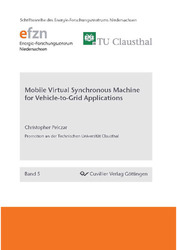| Departments | |
|---|---|
| Book Series (96) |
1378
|
| Nachhaltigkeit |
3
|
| Gesundheitswesen |
1
|
| Humanities |
2364
|
| Medienwissenschaften | 16 |
| Theology | 57 |
| Philosophy | 102 |
| Law | 422 |
| Economics | 850 |
| Social sciences | 416 |
| Sports science | 48 |
| Psychology | 233 |
| Educational science | 190 |
| History | 182 |
| Art | 111 |
| Cultural studies | 166 |
| Literary studies | 116 |
| Linguistics | 88 |
| Natural Sciences |
5406
|
| Engineering |
1793
|
| Common |
98
|
|
Leitlinien Unfallchirurgie
5. Auflage bestellen |
|
Advanced Search
Mobile Virtual Synchronous Machine for Vehicle-to-Grid Applications (Volume 5) (English shop)
Christopher Pelczar (Author)Preview
Table of Contents, Datei (44 KB)
Extract, Datei (98 KB)
The Mobile VISMA is a power electronics device for V2G applications which behaves like an electromechanical synchronous machine and offers the same beneficial properties to the power network, increasing inertia in the system, stabilizing the grid voltage, and providing a short-circuit current in case of grid faults. The VISMA performs a real-time simulation of a synchronous machine and calculates the phase currents that an electromagnetic synchronous machine would produce under the same local grid conditions. These currents are fed into the grid using a current-controlled inverter.
In this dissertation the requirements for a machine model suitable for the VISMA are set, and a mathematical model suitable for use in the VISMA algorithm is found and implemented. A new hardware architecture for the Mobile VISMA based on microcontroller and FPGA technologies is presented. The new architecture allows the reduction of the size and cost of the VISMA, making it suitable for installation in electric vehicles. A simulation model of the inverter hardware and hysteresis current controller is created and validated by experiment. The verified hardware model is then used to design a new type of PWM-based current controller. The performance of the hysteresis- and PWM-based current controllers is evaluated and compared. Finally, the behavior of the VISMA during power network faults is examined, and it is shown that the VISMA, inverter hardware, and current controllers are capable of fault ride-through and can support the power network during faults.
| ISBN-13 (Printausgabe) | 3954040646 |
| ISBN-13 (Hard Copy) | 9783954040643 |
| ISBN-13 (eBook) | 9783736940642 |
| Final Book Format | A5 |
| Language | English |
| Page Number | 168 |
| Lamination of Cover | matt |
| Edition | 1 Aufl. |
| Book Series | Schriftenreihe des Energie-Forschungszentrums Niedersachsen (EFZN) |
| Volume | 5 |
| Publication Place | Göttingen |
| Place of Dissertation | Clausthal |
| Publication Date | 2012-03-23 |
| General Categorization | Dissertation |
| Departments |
Economics
|
| URL to External Homepage | https://www.efzn.de/de/ueber-uns/oeffentlichkeitsarbeit/efzn-schriftenreihe/ |








